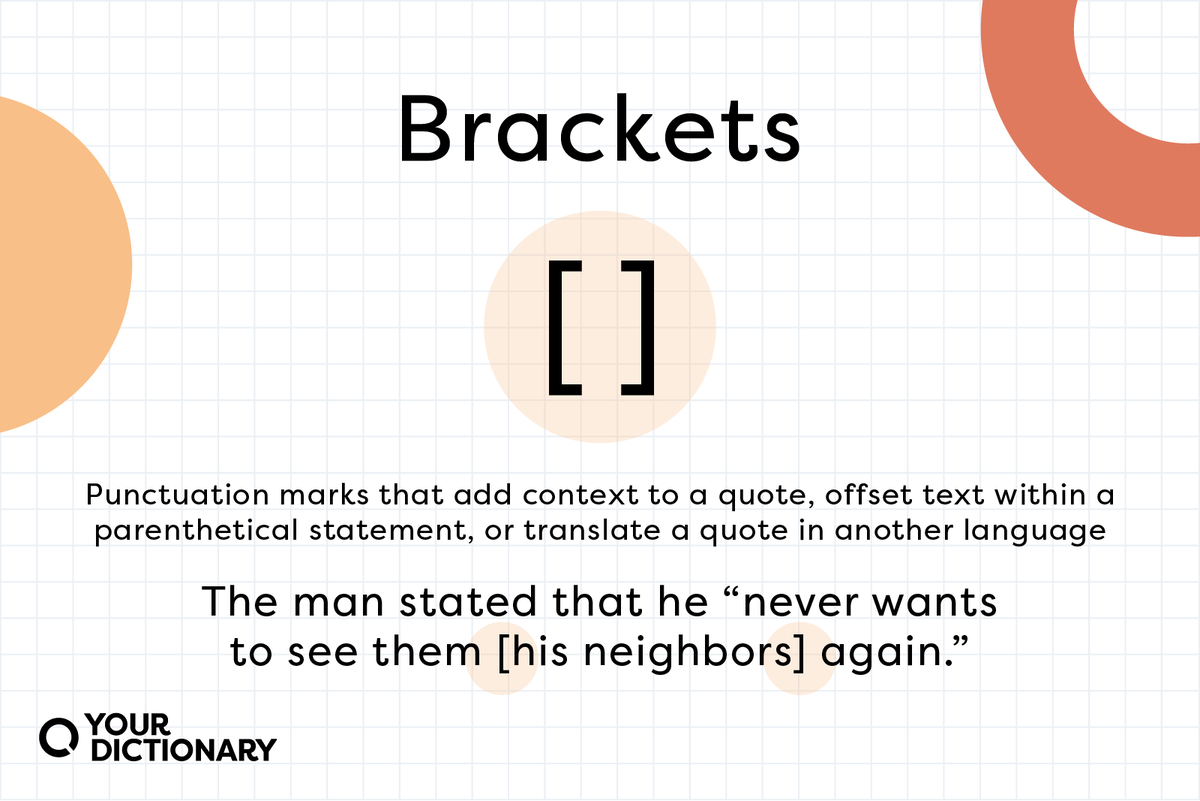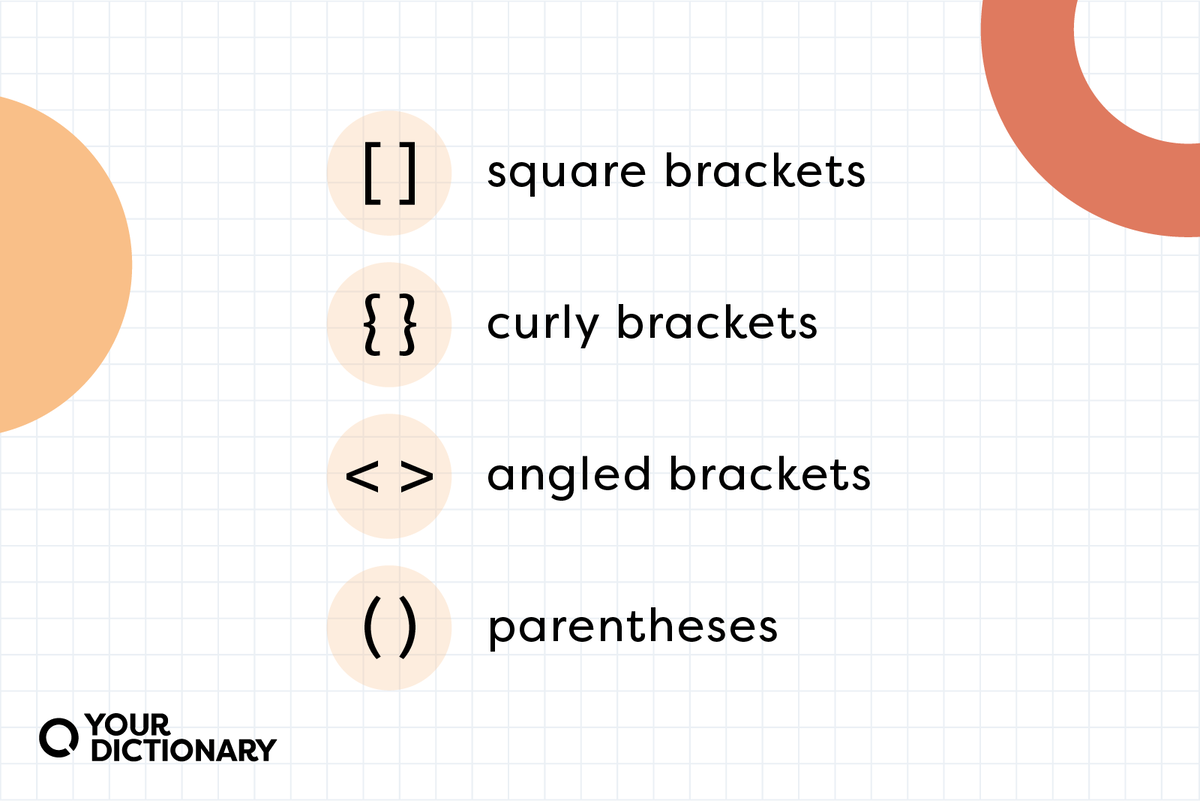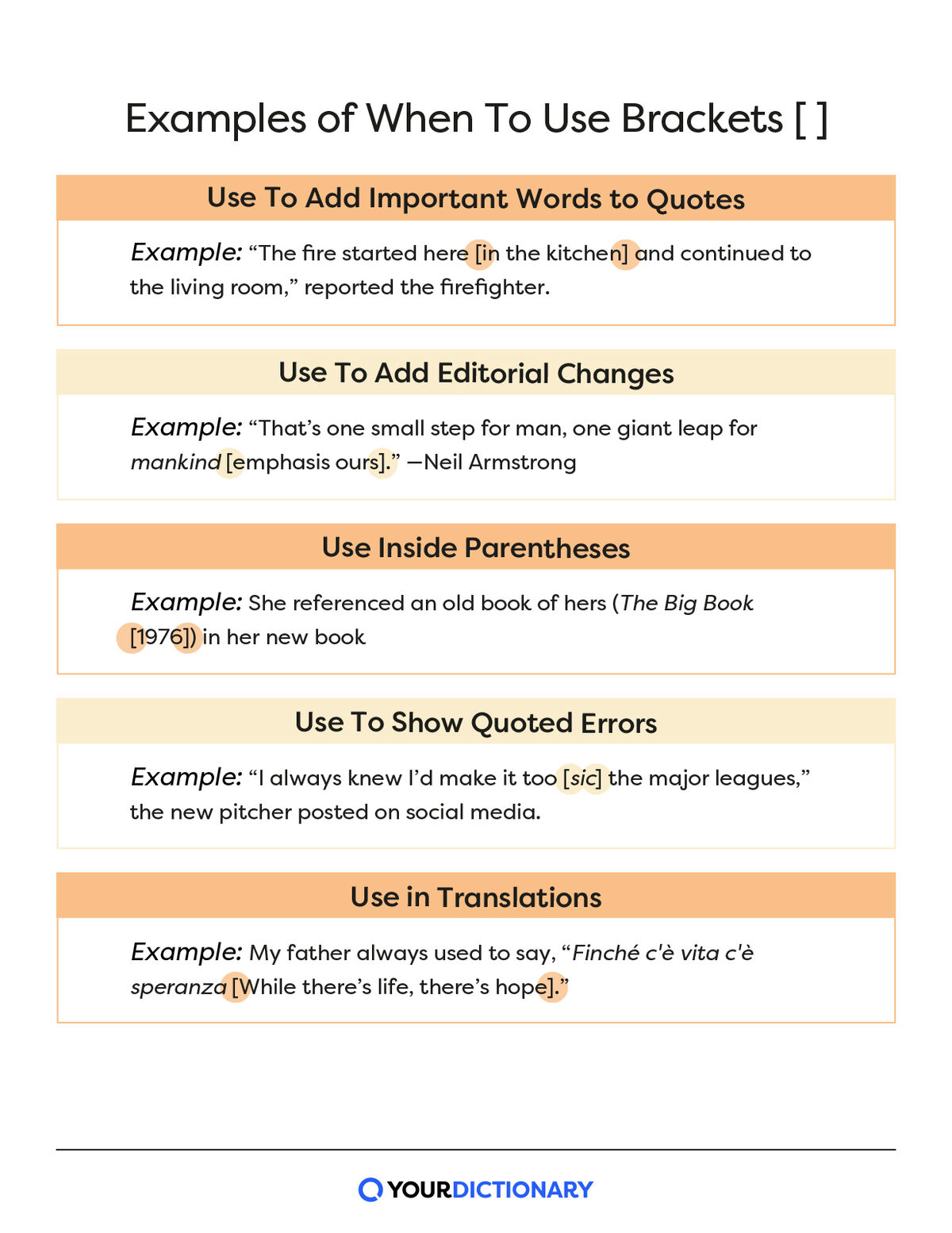
Brackets are more than just square-shaped parentheses — some are curly, others are angled, but they’re all useful in their own ways. Even though you may not use these punctuation marks every day, you should still know what they mean when you see them.
What Are Brackets?
Brackets are punctuation marks that go around text. Like parentheses, brackets function in pairs — one bracket opens the text, and the second bracket closes it [like this]. Brackets are often used to add explanations, corrections, or comments into quoted material.
There are three main types of brackets that you’ll see in writing. They include:
- square brackets [ ]
- curly brackets { }
- angled brackets < >
You may sometimes see reference to rounded brackets — those are just your standard parentheses. When you hear just the word bracket, people are generally referring to square brackets.

Examples of Brackets in a Sentence
Although brackets aren’t as common as parentheses, they’re still quite useful and necessary in many situations.
- The man stated that he “never wants to see them [his neighbors] again.”
- “I’ve never flown a plain [sic] before,” said the soldier.
- You’ll need a copy of the professor’s book (A History of Philosophy [2016]) before attending class.
- As Winston Churchill said, “We shall never surrender [emphasis added].”
- Remember the Spanish proverb “Zapatero, a tus zapatos [Shoemakers, to your shoes].”
Fast Fact
To type a bracket on a computer, hit the bracket key (right after “P” on your keyboard) will give you an opening bracket, and the key next to that one will give you the closing bracket. Easy peasy.
When To Use Brackets
You’re most likely to see and use brackets when dealing with quoted text.
Whether you’re adding context to a quote, offsetting text within a parenthetical statement, or translating a quote in another language, brackets add clarity to your writing.

Use Brackets To Add Important Words to Quotes
Writers use brackets in academic writing to add information to a quote without changing the meaning of the sentence.
This means that the writer can add words, if necessary, to make the sentence clearer or add a correction or comment to quoted material.
If you’re adding words to clarify a word that’s already in the quote, don’t replace that word with your brackets — remember, you can’t change quotes. You can only add to them.
- "Books used [in classes] show methods of finding information but not much information in preparation of the review." (Libutti & Kopala, 1995, p.15).
- “The fire started here [in the kitchen] and continued to the living room,” reported the firefighter.
Use Brackets To Add Editorial Changes
Square brackets allow a writer or editor to fix mistakes within a quote, add explanatory information, change a quote to fit in a sentence, or add emphasis to a word through bold or italics.
- “We adopt the means of nonviolence because our end is a community at peace with itself [italics added].” —Martin Luther King, Jr.
- “That’s one small step for man, one giant leap for mankind [emphasis ours].” —Neil Armstrong
Use Brackets Inside Parentheses
When you’re referencing a book or another written work, add the date of publication in brackets — especially if the book has more than one edition.
- She referenced an old book of hers (The Big Book [1976]) in her new book.
- In Gary’s new book about education (Running Your Classroom [2019]), he discusses the best approach to classroom management in a technology-rich world.
Use Brackets To Show Quoted Errors
Sometimes quotes contain spelling mistakes and grammatical errors.
They may drive editors crazy — but because you can’t change quoted text, those mistakes have to remain.
Editors and writers often use the Latin word sic (meaning “so” or “thus”) to indicate an error was part of the original quote, and they didn’t make the mistake in restating it. Sic is usually italicized and appears inside brackets just after the error.
- “China stole the United States Navy research drone in international waters in an unpresidented [sic] act.”
- “I always knew I’d make it too [sic] the major leagues,” the new pitcher posted on social media.
Use Brackets in Translations
When you’re quoting another language, add the English translation in brackets.
- Jen hired Mel for the movie stating, “That woman just had a certain je ne sais quoi [I don’t know what].”
- My father always used to say, “Finché c'è vita c'è speranza [While there’s life, there’s hope].”
Fast Fact
Brackets also appear in math equations — they group parts of the equation and set them off from other parts. Math usage puts brackets on the outside and parentheses on the inside.
- 103 - [(8 x 9) - (4 x 2)] x 2
You’ll also see curly brackets more often in math than in grammar, as they indicate numbers are in a set. (For example: {1,3,5,7,11} are prime numbers)
Other Types of Brackets
There are a few different types of symbols that can technically be considered brackets. Each pair of marks has its own rules for academic use.
Parentheses or Round Brackets ( )
The most commonly used brackets in English are parentheses. These round brackets add extra (usually non-essential) information to a sentence, or they cite sources.
- George Washington (the first president of the United States) gave his farewell address in 1796.
- The National Aeronautics and Space Administration (NASA) launched its first Mars probe (Viking I) back in 1976.
- Task representations can sometimes differ between student and instructor (Flower, 1994) and even from novice student to more experienced student.
Angled Brackets < >
Angled brackets, also known as chevrons, aren’t common in modern writing. The most common use for angled brackets outside of computer programming is for setting off URLs in text or works cited pages.
Fishman, Stephen M., and Lucille Parkinson McCarthy. John Dewey and the Challenge of Classroom Practice. The Practitioner Inquiry Series. New York Urbana, Ill.: Teachers College Press, National Council of Teachers of English, 1998. <https://searchworks.stanford.edu/view/3885600>
Braces or Curly Brackets { }
Braces, or curly brackets, are mostly used for math, computer programming, or music.
An exception to this would be if a writer wanted to create a list of items that are all equal choices.
Otherwise, this punctuation mark would not be used in academic writing.
Tips for Using Brackets vs. Parentheses
Still need some help when deciding between brackets and parentheses? Ask yourself these questions before choosing rounded or square punctuation marks.
- Is the narrator or speaker adding extra information? Use parentheses.
- Is the editor or reporter adding extra information? Use brackets.
- Could you remove the information and the sentence still makes sense? Use parentheses.
- Does the text include a quote? Use brackets (unless you’re citing the quote).
- Do you already have parentheses? Use brackets inside.